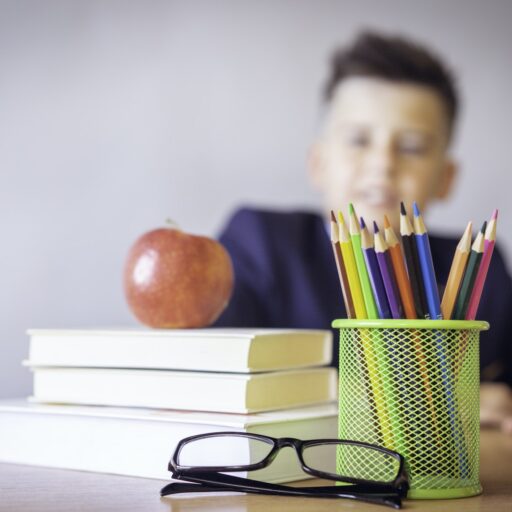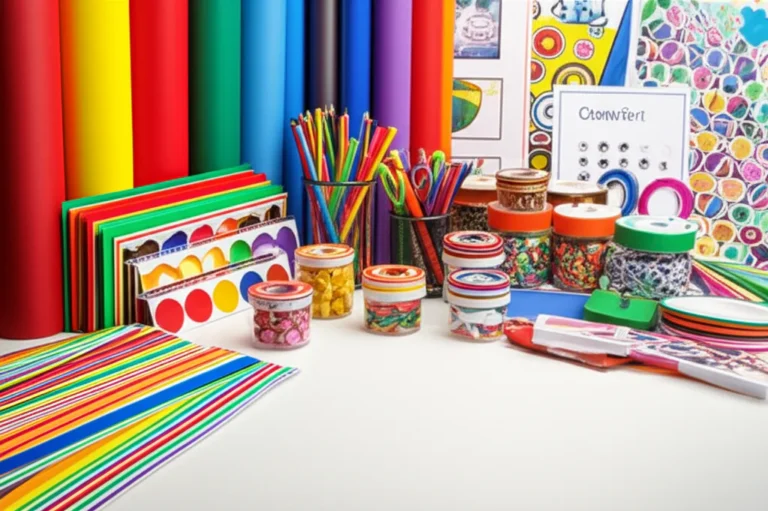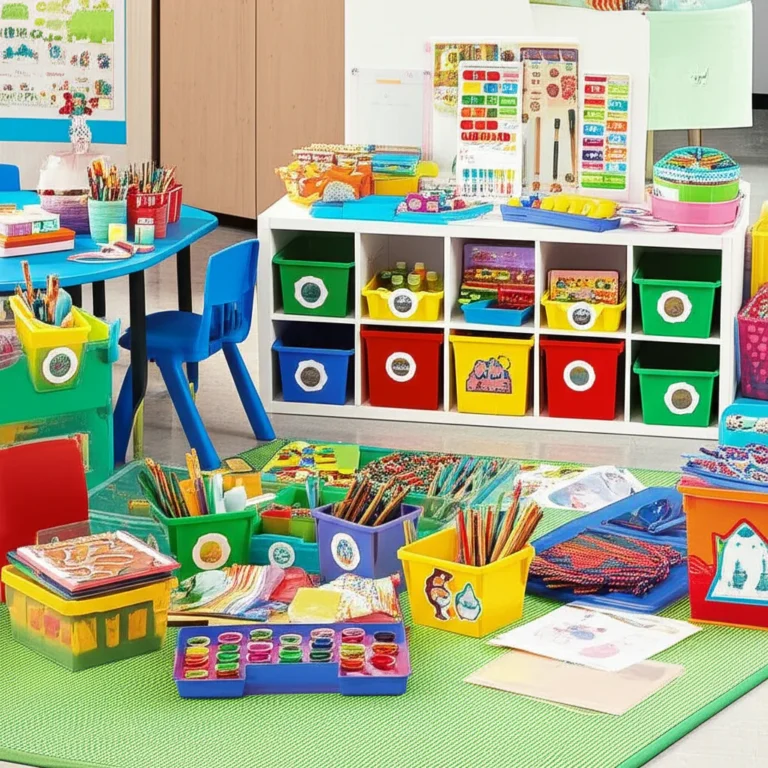Support our educational content for free when you purchase through links on our site. Learn more
[2023] Things a First Year Teacher Needs for the Classroom
Congratulations on embarking on your journey as a first-year teacher! As you step into the classroom, you may be wondering what supplies and materials you need to create an engaging and organized learning environment for your students. In this article, we will provide you with a comprehensive list of things a first-year teacher needs for the classroom. From essential supplies to helpful resources, we’ve got you covered!
Table of Contents
- Quick Answer
- Quick Tips and Facts
- Background
- Essential Classroom Supplies
- Organizational Tools
- Teaching Aids and Decorations
- Technology and Audio-Visual Equipment
- Professional Development Resources
- Classroom Management Tools
- Student Engagement Tools
- FAQ
- Conclusion
- Recommended Links
- Reference Links
Quick Answer
As a first-year teacher, you will need a variety of supplies and resources to create an effective learning environment. Here are the main things you need:
-
Essential Classroom Supplies: pencils, pens, paper, notebooks, folders, binders, scissors, glue sticks, markers, crayons, tissues, hand sanitizer, sticky notes, index cards, rulers, highlighters, erasers, whiteboard markers, construction paper, paint, paintbrushes, paper clips, stapler, staples, tape, calculator, graph paper, rubber bands, pencil sharpener, pencil case, storage bins, classroom labels, cleaning supplies.
-
Organizational Tools: teacher planner, desk organizer, file folders, storage containers, bookshelves, bins, labels, calendar, bulletin board, whiteboard, corkboard, classroom library.
-
Teaching Aids and Decorations: posters, charts, maps, flashcards, educational games, manipulatives, learning centers, classroom decorations.
-
Technology and Audio-Visual Equipment: computer, printer, projector, document camera, speakers, headphones, microphone, interactive whiteboard, tablets, educational software.
-
Professional Development Resources: books, online courses, webinars, conferences, teacher blogs, educational podcasts.
-
Classroom Management Tools: behavior management system, classroom rules, reward system, classroom jobs, attendance tracker, classroom schedule, lesson plan template.
-
Student Engagement Tools: manipulatives, educational games, art supplies, STEM materials, books, puzzles, music, brain breaks, group work materials.
Remember, this is just a starting point, and your specific needs may vary depending on grade level, subject area, and teaching style. Now, let’s dive into each category in more detail!
Shopping Links: Classroom Supplies | Teachers’ Guides | Teacher Planners and Organizers | School Supplies
Quick Tips and Facts
- Organization is key: Having a well-organized classroom will save you time and help create a positive learning environment.
- Start with the essentials: Focus on getting the basic supplies first and then gradually add more materials as needed.
- Consider your teaching style: Think about how you plan to teach and what resources will support your instructional approach.
- Don’t forget about technology: Incorporating technology and audio-visual equipment can enhance your lessons and engage students.
- Professional development is crucial: Take advantage of resources and opportunities to continue learning and growing as an educator.
Background
Starting your first year as a teacher can be both exciting and overwhelming. It’s important to remember that every teacher’s journey is unique, and there is no one-size-fits-all approach to teaching. However, there are certain supplies and resources that can help set you up for success in your first year.
Essential Classroom Supplies
Having the right classroom supplies is essential for creating a productive learning environment. Here are some must-have supplies for your first year:
| Supplies | Description |
|---|---|
| Pencils | Essential for students to complete assignments and activities. |
| Pens | Useful for grading papers and taking notes. |
| Paper | Provide students with a variety of paper types for different assignments. |
| Notebooks | Students can use notebooks to keep track of their notes and assignments. |
| Folders | Help students stay organized by providing folders for different subjects. |
| Binders | Keep important documents and handouts organized with binders. |
| Scissors | Useful for arts and crafts projects. |
| Glue sticks | Provide students with glue sticks for projects and assignments. |
| Markers | Use markers for creating charts, posters, and other visual aids. |
| Crayons | Essential for younger students to express their creativity. |
| Tissues | Keep a box of tissues in the classroom for runny noses and spills. |
| Hand sanitizer | Promote good hygiene by providing hand sanitizer for students. |
| Sticky notes | Useful for reminders, bookmarks, and interactive activities. |
| Index cards | Great for flashcards and organizing information. |
| Rulers | Help students with measurements and drawing straight lines. |
| Highlighters | Useful for emphasizing important information in textbooks and notes. |
| Erasers | Provide students with erasers for correcting mistakes. |
| Whiteboard markers | Use whiteboard markers for interactive lessons and brainstorming. |
| Construction paper | Great for arts and crafts projects and creating displays. |
| Paint | Encourage creativity with a variety of paint colors. |
| Paintbrushes | Provide students with different sizes of paintbrushes for various projects. |
| Paper clips | Keep papers organized with paper clips. |
| Stapler | Essential for attaching papers together. |
| Staples | Make sure you have enough staples for your stapler. |
| Tape | Use tape for hanging posters, artwork, and other classroom decorations. |
| Calculator | Provide students with calculators for math and science activities. |
| Graph paper | Useful for graphing and plotting equations. |
| Rubber bands | Keep a supply of rubber bands for various classroom needs. |
| Pencil sharpener | Make sure pencils are always sharp and ready for use. |
| Pencil case | Help students keep their pencils and other small supplies organized. |
| Storage bins | Use storage bins to keep supplies organized and easily accessible. |
| Classroom labels | Labeling bins, shelves, and other areas will help keep your classroom organized. |
| Cleaning supplies | Keep your classroom clean and tidy with cleaning supplies. |
Shopping Links: Pencils | Pens | Paper | Notebooks | Folders | Binders | Scissors | Glue Sticks | Markers | Crayons | Tissues | Hand Sanitizer | Sticky Notes | Index Cards | Rulers | Highlighters | Erasers | Whiteboard Markers | Construction Paper | Paint | Paintbrushes | Paper Clips | Stapler | Staples | Tape | Calculator | Graph Paper | Rubber Bands | Pencil Sharpener | Pencil Case | Storage Bins | Classroom Labels | Cleaning Supplies
Organizational Tools
Being organized is essential for managing your classroom effectively. Here are some organizational tools that can help you stay on top of things:
- Teacher Planner: A teacher planner is a valuable tool for keeping track of lesson plans, meetings, and important dates. It can also serve as a reflection and goal-setting tool.
- Desk Organizer: Keep your desk tidy and organized with a desk organizer. It will help you find essential items quickly and reduce clutter.
- File Folders: Use file folders to organize paperwork, handouts, and other important documents. Label each folder for easy reference.
- Storage Containers: Invest in storage containers to keep supplies, manipulatives, and other materials organized. Clear containers make it easy to see what’s inside.
- Bookshelves: Create a classroom library by adding bookshelves to your classroom. Organize books by genre, reading level, or topic.
- Bins: Use bins to store and organize materials such as art supplies, manipulatives, and stationery.
- Labels: Label everything in your classroom, from bins to shelves, to help students find what they need and maintain order.
- Calendar: Hang a calendar in your classroom to keep track of important dates, events, and holidays.
- Bulletin Board: Create a bulletin board to display student work, important announcements, and educational content.
- Whiteboard: A whiteboard is a versatile tool for teaching and displaying information. Use it for brainstorming, solving problems, and explaining concepts.
- Corkboard: Hang a corkboard in your classroom to display important notices, reminders, and student achievements.
- Classroom Library: Create a cozy reading corner with a variety of books for students to explore and enjoy.
Shopping Links: Teacher Planner | Desk Organizer | File Folders | Storage Containers | Bookshelves | Bins | Labels | Calendar | Bulletin Board | Whiteboard | Corkboard | Classroom Library
Teaching Aids and Decorations
Teaching aids and decorations can make your classroom visually appealing and enhance the learning experience. Here are some ideas:
- Posters: Hang educational posters that reinforce concepts, display inspirational quotes, or provide visual aids for different subjects.
- Charts: Use charts to help students understand and remember important information. Examples include multiplication tables, grammar rules, and scientific processes.
- Maps: Hang maps to teach geography and promote global awareness.
- Flashcards: Create or purchase flashcards to help students practice vocabulary, math facts, and other important concepts.
- Educational Games: Incorporate educational games into your lessons to make learning fun and engaging.
- Manipulatives: Provide students with hands-on materials such as counters, blocks, and shapes to support their understanding of abstract concepts.
- Learning Centers: Set up learning centers in your classroom to provide students with opportunities for independent and small-group learning.
- Classroom Decorations: Add decorative elements such as banners, bunting, and borders to create an inviting and stimulating learning environment.
Shopping Links: Posters | Charts | Maps | Flashcards | Educational Games | Manipulatives | Learning Centers | Classroom Decorations
Technology and Audio-Visual Equipment
Incorporating technology and audio-visual equipment into your lessons can enhance student engagement and facilitate learning. Here are some essential tools:
- Computer: A computer is a versatile tool for lesson planning, research, and creating instructional materials.
- Printer: Invest in a printer to print worksheets, handouts, and other teaching resources.
- Projector: Use a projector to display presentations, videos, and other multimedia content to the whole class.
- Document Camera: A document camera allows you to display books, worksheets, and student work on a larger screen.
- Speakers: Connect speakers to your computer or projector to amplify sound and make audio content more accessible.
- Headphones: Provide students with headphones for individual work or listening to audio materials.
- Microphone: If you have a large classroom or need to project your voice, a microphone can help ensure that all students can hear you clearly.
- Interactive Whiteboard: An interactive whiteboard allows you to write, draw, and interact with digital content using touch or a stylus.
- Tablets: Tablets can be used for interactive activities, research, and accessing educational apps.
- Educational Software: Explore educational software that aligns with your curriculum and enhances student learning.
Shopping Links: Computer | Printer | Projector | Document Camera | Speakers | Headphones | Microphone | Interactive Whiteboard | Tablets | Educational Software
Professional Development Resources
Continuing your professional development is crucial for growth as an educator. Here are some resources to consider:
- Books: Read books on teaching strategies, classroom management, and subject-specific pedagogy.
- Online Courses: Take online courses to deepen your knowledge in specific areas or earn professional development credits.
- Webinars: Attend webinars on various educational topics to learn from experts in the field.
- Conferences: Attend educational conferences to network with other educators and gain new insights and ideas.
- Teacher Blogs: Follow teacher blogs for practical tips, lesson ideas, and inspiration from experienced educators.
- Educational Podcasts: Listen to educational podcasts to stay up-to-date with the latest research and trends in education.
Shopping Links: Books | Online Courses | Webinars | Conferences | Teacher Blogs | Educational Podcasts
Classroom Management Tools
Effective classroom management is essential for creating a positive and productive learning environment. Here are some tools to help you manage your classroom:
- Behavior Management System: Develop a behavior management system that includes clear expectations, rules, and consequences.
- Classroom Rules: Establish classroom rules that promote respect, responsibility, and a positive learning environment.
- Reward System: Implement a reward system to recognize and reinforce positive behavior and academic achievements.
- Classroom Jobs: Assign classroom jobs to students to promote responsibility and a sense of ownership in the classroom.
- Attendance Tracker: Keep track of student attendance using an attendance tracker to monitor attendance patterns and identify trends.
- Classroom Schedule: Create a visual classroom schedule to help students understand the daily routine and transitions.
- Lesson Plan Template: Use a lesson plan template to plan and organize your lessons effectively.
Shopping Links: Behavior Management System | Classroom Rules | Reward System | Classroom Jobs | Attendance Tracker | Classroom Schedule | Lesson Plan Template
Student Engagement Tools
Engaging students in the learning process is essential for their academic success. Here are some tools to promote student engagement:
- Manipulatives: Use manipulatives such as counters, blocks, and shapes to make abstract concepts more tangible and engaging.
- Educational Games: Incorporate educational games into your lessons to make learning fun and interactive.
- Art Supplies: Provide students with art supplies to encourage creativity and self-expression.
- STEM Materials: Engage students in hands-on STEM (Science, Technology, Engineering, and Math) activities with materials such as building blocks, circuits, and robotics kits.
- Books: Create a classroom library with a variety of books to foster a love of reading and provide opportunities for independent reading.
- Puzzles: Use puzzles to develop problem-solving skills and critical thinking.
- Music: Incorporate music into your lessons to create a positive and engaging learning environment.
- Brain Breaks: Take short breaks during lessons for physical activity or relaxation to help students refocus and recharge.
- Group Work Materials: Provide materials such as whiteboards, markers, and collaboration tools to facilitate group work and cooperative learning.
Shopping Links: Manipulatives | Educational Games | Art Supplies | STEM Materials | Books | Puzzles | Music | Brain Breaks | Group Work Materials
FAQ
What do first year teachers need support in?
First-year teachers often need support in various areas as they navigate their new role. Here are some common areas where support is beneficial:
-
Classroom Management: Establishing effective classroom management strategies can be challenging for new teachers. Seek guidance from experienced teachers or attend professional development workshops on classroom management techniques.
-
Curriculum Planning: Developing lesson plans and aligning them with curriculum standards can be overwhelming. Collaborate with colleagues, use online resources, and seek guidance from your school’s curriculum coordinator.
-
Differentiation: Meeting the diverse needs of students can be a challenge. Learn about differentiation strategies and seek support from special education teachers or instructional coaches.
-
Parent Communication: Building positive relationships with parents is crucial. Seek advice from experienced teachers on effective communication strategies and attend parent-teacher conferences and workshops.
-
Self-Care: Teaching can be emotionally and physically demanding. Take care of yourself by setting boundaries, practicing self-care activities, and seeking support from colleagues or a mentor.
What supplies do I need as a new teacher?
As a new teacher, you will need a variety of supplies to create an effective learning environment. Some essential supplies include:
- Pencils
- Pens
- Paper
- Notebooks
- Folders
- Binders
- Scissors
- Glue sticks
- Markers
- Crayons
- Tissues
- Hand sanitizer
- Sticky notes
- Index cards
- Rulers
- Highlighters
- Erasers
- Whiteboard markers
- Construction paper
- Paint
- Paintbrushes
- Paper clips
- Stapler
- Staples
- Tape
- Calculator
- Graph paper
- Rubber bands
- Pencil sharpener
- Pencil case
- Storage bins
- Classroom labels
- Cleaning supplies
Read more about “… Primary Teacher Must-Haves: Supplies and Learning Materials for Your Class”
What do I need to set up my first classroom?
Setting up your first classroom requires careful planning and organization. Here are some essential items you will need:
- Classroom furniture (desks, chairs, tables)
- Whiteboard or chalkboard
- Bulletin board or corkboard
- Classroom library
- Storage shelves or bins
- Teacher desk and chair
- Student desks or tables
- Classroom rugs or seating areas
- Classroom decorations (posters, charts, maps)
- Classroom supplies (pencils, paper, markers, etc.)
- Organizational tools (teacher planner, file folders, labels)
- Technology and audio-visual equipment (computer, projector, speakers)
- Classroom management tools (behavior management system, classroom rules)
- Student engagement tools (manipulatives, educational games, art supplies)
Read more about “… Classroom Essentials for New Teachers: 20 Must-Have Supplies”
What should be required of teachers in the classroom?
Teachers play a vital role in the education and development of their students. Here are some important responsibilities and expectations for teachers in the classroom:
-
Instruction: Teachers are responsible for planning and delivering effective instruction that meets the needs of all students. This includes designing engaging lessons, assessing student progress, and providing timely feedback.
-
Classroom Management: Teachers are responsible for creating a positive and inclusive learning environment. This includes establishing clear expectations, managing student behavior, and promoting a safe and respectful classroom culture.
-
Differentiation: Teachers should differentiate instruction to meet the diverse needs of their students. This includes adapting lessons, providing accommodations, and modifying assessments to ensure all students can access the curriculum.
-
Assessment and Evaluation: Teachers are responsible for assessing student learning and providing feedback. This includes designing and administering assessments, analyzing data, and using assessment results to inform instruction.
-
Collaboration: Teachers should collaborate with colleagues, parents, and other stakeholders to support student learning. This includes participating in team meetings, communicating with parents, and seeking input from colleagues.
-
Professional Development: Teachers should engage in ongoing professional development to enhance their knowledge and skills. This includes attending workshops, conferences, and pursuing advanced degrees or certifications.
Read more about “… The Ultimate Teacher Supply List: Must-Have Items for Your Classroom”
How can I continue learning and growing as a first-year teacher?
Continuing your learning and professional growth is essential as a first-year teacher. Here are some ways to continue learning and growing:
-
Reflect on Your Practice: Take time to reflect on your teaching practice and identify areas for improvement. Consider keeping a reflective journal or seeking feedback from colleagues or mentors.
-
Seek Professional Development Opportunities: Attend workshops, conferences, and webinars to learn about new teaching strategies and best practices. Look for professional development opportunities offered by your school, district, or educational organizations.
-
Join Professional Learning Communities: Join or create a professional learning community with other teachers in your school or district. Collaborate, share ideas, and learn from one another.
-
Read Professional Books and Articles: Read books and articles on teaching pedagogy, classroom management, and subject-specific strategies. Stay up-to-date with the latest research and trends in education.
-
Connect with Experienced Teachers: Seek guidance and mentorship from experienced teachers. They can provide valuable insights and support as you navigate your first year.
-
Reflect on Student Feedback: Listen to your students’ feedback and adjust your teaching accordingly. Their insights can help you improve your instructional practices.
-
Take Care of Yourself: Prioritize self-care to avoid burnout. Make time for hobbies, exercise, and relaxation. Seek support from colleagues, friends, or a mentor when needed.
Conclusion
As a first-year teacher, having the right supplies and resources can make a significant difference in creating a successful learning environment. From essential classroom supplies to organizational tools, teaching aids, and professional development resources, there are many things to consider. Remember to adapt these suggestions to your specific grade level, subject area, and teaching style.
Investing in quality supplies and resources will not only benefit your students but also make your teaching experience more enjoyable and effective. As you embark on your teaching journey, remember to stay open to learning, seek support when needed, and celebrate your successes along the way.
Recommended Links
- 2023 Ultimate Student Supply List: Everything You Need for a Successful School Year
- Classroom Supplies
- Teachers’ Guides
- Teacher Planners and Organizers
- School Supplies





